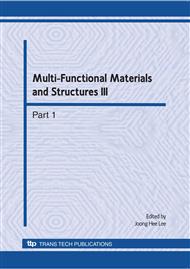p.655
p.659
p.663
p.667
p.671
p.675
p.679
p.683
p.687
Exfoliation of Graphite via Edge-Functionalization with Carboxylic Acid-Terminated Hyperbranched Poly(ether-ketone)s
Abstract:
Because the complete restoration of graphene oxide into graphene is unsuccessful, the “direct” exfoliation of graphite into graphene is still remaining challenge. Here, we report in-situ grafting of carboxylic acid-terminated hyperbranched poly(ether-ketone) (HPEK) onto the edge of graphite to afford “edge-functionalized” HPEK grafted graphite (HPEK-g-graphite). The HPEK plays as a macromolecular wedge to exfoliate graphite. The degree of exfoliation of the resultant HPEK-g-graphite was estimated by wide-angle x-ray diffraction (WAXD), transmission electron microscopy (TEM). Due to the macromolecular wedge effect, the resultant HPEK-g-graphite was dispersible well in common organic solvents. Hence, HPEK-g-graphite could be potentially useful for graphene-based materials.
Info:
Periodical:
Pages:
671-674
Citation:
Online since:
August 2010
Authors:
Price:
Сopyright:
© 2010 Trans Tech Publications Ltd. All Rights Reserved
Share:
Citation:



